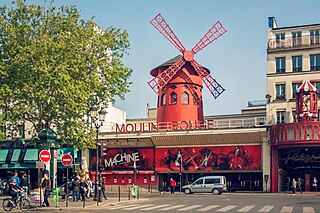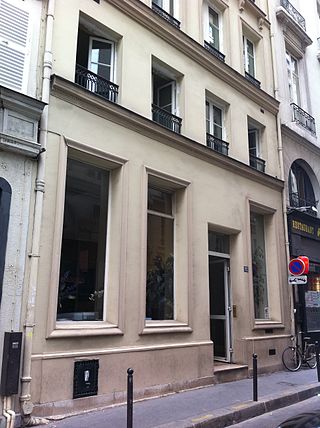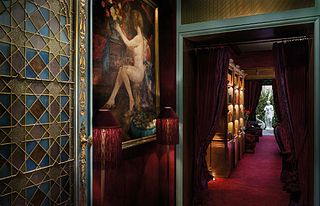
Moulin Rouge is a cabaret in Paris, on Boulevard de Clichy, at Place Blanche, the intersection of, and terminus of Rue Blanche.

Comte Henri Marie Raymond de Toulouse-Lautrec-Monfa, known as Toulouse Lautrec, was a French painter, printmaker, draughtsman, caricaturist, and illustrator whose immersion in the colourful and theatrical life of Paris in the late 19th century allowed him to produce a collection of enticing, elegant, and provocative images of the sometimes decadent affairs of those times.

Édith Piaf was a French singer. Noted as France's national chanteuse, she was one of the country's most widely known international stars.

Le Sphinx was a maison close (brothel) in Paris in the 1930s and 1940s. Along with the "Le Chabanais" and "One-Two-Two" it was considered one of the most luxurious and famous Parisian brothels.

Prostitution in France was legal until April 2016, but several surrounding activities were illegal, like operating a brothel, living off the avails (pimping), and paying for sex with someone under the age of 18.

Le Chabanais was one of the best known and most luxurious brothels in Paris, operating near the Louvre at 12 rue Chabanais from 1878 until 1946, when brothels were outlawed in France. It was founded by the Irish-born Madame Kelly, who was closely acquainted with several members at the Jockey-Club de Paris. Among the habituées were Albert, Prince of Wales ; Henri de Toulouse-Lautrec; Cary Grant; Humphrey Bogart, Mae West and diplomatic guests of the French government.

Le Divan du Monde is a converted theatre, now functioning as a concert space, located at 75 rue des Martyrs, in the 18th arrondissement, in the Pigalle neighborhood of Paris.

Marguerite Gourdan, née Marguerite Alexandrine Ernestine Stock was a French brothel owner and procurer in 18th-century Paris. Her brothel was the most exclusive in Paris during that age, and Gourdan was arguably the most famous of her profession.

Virgile Rossel was a Swiss jurist, politician and writer. He was President of the Swiss National Council in 1909/1910 and President of the Federal Supreme Court 1929–1930.
Loi Marthe Richard of April 13, 1946 abolished the regime of regulated prostitution in France that had been in force since 1804. It required the closure of brothels. The law bears the name of Marthe Richard, who was a municipal councillor of Paris but not a parliamentary representative.
Soupeur is a sexual practice involving attraction to other male secretions, specifically bread soaked in urine, or semen.

Maison Souquet is a 5-star hotel, part of Maisons Particulieres Collection, located at 10, rue de Bruxelles in Paris, on the outskirts of Montmartre. The hotel is inspired by the Parisian brothels from the Belle Époque period. Maison Souquet is decorated by the French designer Jacques Garcia.

The One-Two-Two was one of the most luxurious and illustrious brothels of Paris in the 1930s and 1940s. The name was taken from the address, 122 Rue de Provence, 8th arrondissement of Paris. The numbers were translated into English to ensure that foreign tourists would be able to find the brothel and as a password for French people.

The Aux Belles Poules was a well-known Parisian maison close (brothel), established at 32-34 Rue Blondel in the 2nd Arrondissement.
The Brigade de répression du proxénétisme (BRP) is a judicial police service of the French National Police, responsible for the surveillance of prostitution and the repression of procuring.
The authorities of medieval Paris attempted to confine prostitution to a particular district. Louis IX (1226–1270) designated nine streets in the Beaubourg Quartier where it would be permitted. In the early part of the 19th century, state-controlled legal brothels started to appear in several French cities. By law, they had to be run by a woman and their external appearance had to be discreet. The maisons were required to light a red lantern when they were open (from which is derived the term red-light district and the prostitutes were only permitted to leave the maisons on certain days and only if accompanied by its head. By 1810, Paris alone had 180 officially approved brothels.

Alfred Louis Auguste Poux, better known by his pen name Alfred Franklin, (1830–1917) was a French librarian, historian, and writer.

Le Lit is a painting by Henri de Toulouse-Lautrec from around 1892 which depicts two women sharing a bed. The painting has been held by public collections in France since 1937, and by the Musée d'Orsay in Paris since 1986.
Prostitution in Paris, both in street form and in dedicated facilities has had a long history and remains present to this day.

The history of prostitution in France has similarities with the history of prostitution in other countries in Europe, namely a succession of periods of tolerance and repression, but with certain distinct features such as a relatively long period of tolerance of brothels.





















